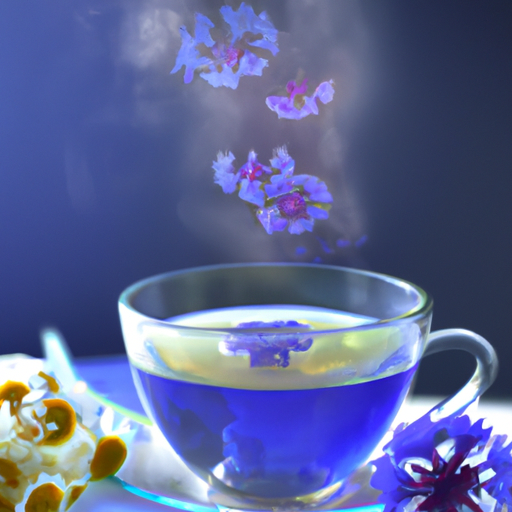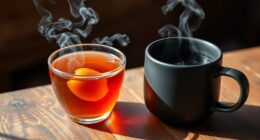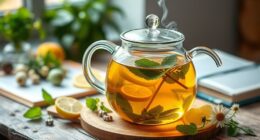Picture yourself strolling through a green garden, enveloped by colorful flowers and alluring scents. Within this beautiful botanical oasis, you come across a mesmerizing plant called the passion flower. Its exquisite petals, reminiscent of a masterpiece, invite you to come nearer.
Little do you know, this humble plant holds the key to a soothing and therapeutic elixir – passion flower tea.
In this article, I will guide you through the process of making passion flower tea from the plant itself. With its rich history and numerous health benefits, this tea has become a cherished addition to relaxation routines around the world.
By following a few simple steps, you can transform fresh passion flower leaves and flowers into a fragrant and calming beverage. So, let us embark on a journey of discovery, as we unlock the secrets of this remarkable plant and savor the tranquility it brings.
Key Takeaways
- Passion flower tea is made from the passion flower plant and has been used for centuries for its health benefits.
- It is known for its soothing effects and is used as a natural remedy for anxiety and insomnia.
- Passion flower tea improves sleep quality, reduces stress and anxiety levels, and has anti-inflammatory properties.
- To make passion flower tea, gather fresh passion flower leaves and flowers, rinse them, boil water, steep the leaves and flowers, strain the tea, and optionally add sweeteners or flavorings to taste.
Introduction to Passion Flower Tea
Passion flower tea is a delicious and calming beverage that can be easily made from the passion flower plant. It’s been used for centuries due to its numerous health benefits. This tea isn’t only refreshing but also boasts a wide range of therapeutic properties.
Passion flower tea is known for its soothing effects and is often used as a natural remedy for anxiety and insomnia. It contains compounds that have a calming effect on the central nervous system, promoting relaxation and reducing stress and anxiety levels. Additionally, passion flower tea has been found to improve sleep quality, making it an excellent option for those struggling with insomnia or restlessness.
The benefits of passion flower tea extend beyond its calming properties. It’s rich in antioxidants, which help protect the body against damage from harmful free radicals. These antioxidants also have anti-inflammatory properties, which can help reduce inflammation in the body and support overall health.
To make passion flower tea, the first step is to gather fresh passion flower leaves and flowers. You can find these on the passion flower plant, which typically grows in warm climates. Harvest the leaves and flowers when they’re fully matured and have a vibrant color. Once you’ve gathered them, you can proceed to the next step of preparing the tea.
Gather Fresh Passion Flower Leaves and Flowers
First, you’ll want to gather the fresh leaves and flowers of this beautiful plant. Harvesting techniques for passion flower leaves and flowers are simple yet crucial to ensure maximum potency and flavor in your tea. When gathering the leaves, choose those that are young and vibrant, as they contain the highest concentration of active compounds. Gently pluck the leaves from the stem, making sure to avoid any damaged or discolored ones. As for the flowers, pick them when they are fully bloomed and their petals are vibrant and intact. Separate the flowers from the stem, discarding any wilted or damaged ones. To give you a visual representation, here is a table showcasing the ideal characteristics of passion flower leaves and flowers:
| Leaves | Flowers |
|---|---|
| Young | Fully bloomed |
| Vibrant green | Vibrant petals |
| No damage or discoloration | Intact and healthy |
| Fresh aroma | Aromatic fragrance |
Aside from making tea, passion flower leaves and flowers have alternative uses in herbal medicine and aromatherapy due to their calming and sedative properties. Now, let’s move on to preparing the passion flower leaves and flowers for your tea.
Prepare the Passion Flower Leaves and Flowers
To prepare the leaves and flowers of the passion flower, it’s important to handle them carefully to preserve their potency and flavor. Did you know that passion flower leaves contain over 30 active compounds that contribute to their calming effects?
When preparing passion flower tea, follow these steps to ensure the best results:
-
Harvest fresh passion flower leaves and flowers from your plant. Look for leaves that are vibrant green and flowers that are fully bloomed. These are the parts of the plant that contain the highest concentration of beneficial compounds.
-
Rinse the leaves and flowers under cool water to remove any dirt or debris. Gently pat them dry with a clean towel.
-
Carefully remove the stems from the leaves and discard them. You want to use only the leafy parts of the plant for making tea.
Preparing passion flower tea offers numerous benefits. Not only does it promote relaxation and reduce anxiety, but it also aids in improving sleep quality and reducing inflammation in the body. The passion flower’s potent compounds work synergistically to provide these therapeutic effects.
Now that the leaves and flowers are prepared, it’s time to move on to the next step: boiling water and steeping the passion flower leaves and flowers.
Boil Water and Steep the Passion Flower Leaves and Flowers
Once you’ve prepared the vibrant green leaves and fully bloomed flowers, it’s time to bring water to a boil and steep them for the perfect infusion. Boiling water is an essential step in extracting the beneficial compounds present in the passion flower leaves and flowers. It helps to break down the cell walls and release their therapeutic properties.
When it comes to brewing passion flower tea, there are alternative methods you can explore. Some people prefer cold steeping, where you let the leaves and flowers sit in cold water for several hours. This method is believed to preserve more of the delicate compounds and flavors. However, for a more potent infusion, boiling water is recommended.
To prepare passion flower tea using boiling water, bring a pot of water to a rolling boil. Once the water reaches its boiling point, carefully add the prepared passion flower leaves and flowers. Allow them to steep for about 10-15 minutes, ensuring that the water remains at a gentle simmer. This will extract the maximum medicinal benefits from the plant material.
After steeping, strain the passion flower tea using a fine mesh strainer or cheesecloth. This will remove any plant material and ensure a smooth and enjoyable tea-drinking experience. Now that you have a fragrant and healing cup of passion flower tea, let’s move on to the next step of straining and enjoying the infusion.
Strain the Passion Flower Tea
Now that the infusion’s complete, it’s time to sieve out the delicate remnants of the passion flower leaves and flowers, leaving behind a pure and velvety elixir. Straining the passion flower tea is a crucial step in the preparation process as it ensures a smooth and enjoyable drinking experience.
There are different ways to strain passion flower tea, but I highly recommend using a fine mesh strainer for optimal results. A fine mesh strainer is perfect for capturing all the tiny particles of the passion flower leaves and flowers, preventing them from ending up in your cup. Its tightly woven mesh allows for efficient straining while retaining the essential oils and flavors of the passion flower. This type of strainer also works well for filtering out any impurities or debris that may have been introduced during the steeping process.
Using a fine mesh strainer not only helps in achieving a visually appealing tea but also enhances the overall taste and texture. The clear and pure liquid that passes through the strainer will have a velvety smoothness, making each sip a delightful experience.
Now that the passion flower tea’s been strained, it’s time to move on to the next step of adding sweeteners or flavorings to taste.
Optional: Add Sweeteners or Flavorings to Taste
Feeling like indulging your taste buds? Go ahead and jazz up your passion flower elixir with a touch of sweetness or a burst of flavor to make it truly your own. Here are some sweetener alternatives and different flavor combinations to explore:
-
Sweetener alternatives: If you prefer a natural sweetener, try adding a teaspoon of honey or maple syrup. For a sugar-free option, stevia or monk fruit extract can be used as well. These alternatives provide a hint of sweetness without overpowering the delicate flavors of the passion flower tea.
-
Flavor combinations: To enhance the taste of your passion flower tea, experiment with different flavor combinations. For a refreshing twist, add a few slices of lemon or lime. If you enjoy a floral aroma, try infusing the tea with a sprig of lavender or rose petals. For a spicy kick, consider adding a pinch of ginger or a cinnamon stick.
By adding sweeteners or flavorings, you can elevate the taste of your passion flower tea and customize it to suit your preferences. Once you’ve achieved the desired flavor profile, it’s time to move on to the next step – serving and enjoying your homemade passion flower tea.
Serve and Enjoy Your Homemade Passion Flower Tea
To savor the fruits of your labor, bask in the delightful aroma and relish the flavor of your custom-crafted elixir made with passion and creativity. Once your passion flower tea is brewed to perfection, there are several different ways to serve and enjoy it.
For a simple and traditional approach, you can pour the tea into a cup and enjoy it hot. If you prefer a chilled beverage, you can let the tea cool and then add ice cubes for a refreshing iced tea experience. Another option is to infuse your passion flower tea with other flavors by adding a slice of lemon or a sprig of mint. This can enhance the taste and create a unique twist to your tea.
Additionally, you may explore potential uses for passion flower tea beyond just drinking it. It can be used as a base for cocktails or as a flavoring ingredient in desserts and baked goods. With its calming properties and distinct taste, passion flower tea is a versatile addition to your culinary repertoire.
Transitioning into the subsequent section about the health benefits of passion flower tea, it’s important to note that its versatility extends beyond just taste.
Health Benefits of Passion Flower Tea
Indulge in the numerous health benefits of this aromatic brew by sipping on a cup of passion flower tea. This delightful herbal infusion not only offers a calming and soothing effect but also provides various medicinal properties that can promote overall well-being.
Here are some of the remarkable health benefits of passion flower tea:
-
Relieves Anxiety: Passion flower tea has been used for centuries to alleviate anxiety and promote relaxation. It’s natural compounds, such as flavonoids and alkaloids, help reduce anxiety symptoms by boosting the levels of gamma-aminobutyric acid (GABA) in the brain.
-
Improves Sleep Quality: Passion flower tea is known for its sedative properties, making it an excellent choice for those struggling with insomnia or other sleep disorders. The tea helps calm the mind and relax the body, allowing for a more restful and rejuvenating sleep.
-
Reduces Inflammation: The bioactive compounds in passion flower tea possess anti-inflammatory properties that can help reduce inflammation throughout the body. This can be particularly beneficial for individuals with conditions such as arthritis or inflammatory bowel disease.
Incorporating passion flower tea into your daily routine can offer a range of health benefits, from anxiety relief to improved sleep and reduced inflammation. However, it’s important to be aware of potential precautions and side effects associated with its consumption.
Precautions and Potential Side Effects
Now that we’ve explored the numerous health benefits of passion flower tea, it’s important to also consider the potential precautions and side effects associated with its consumption.
While passion flower tea is generally safe for most people when consumed in moderate amounts, it is crucial to be aware of potential dangers.
Firstly, it’s recommended to consult with a healthcare professional before incorporating passion flower tea into your routine, particularly if you have any existing medical conditions or are taking medications. This is because passion flower tea may interact with certain medications, such as sedatives or anti-anxiety drugs, leading to increased drowsiness or dizziness.
Additionally, consuming passion flower tea in excessive amounts may cause nausea, vomiting, or even liver toxicity. It’s essential to stick to the recommended dosage and not exceed the suggested intake. As a general guideline, one cup of passion flower tea per day is considered safe for most individuals.
While passion flower tea offers a range of health benefits, it’s important to exercise caution and be aware of potential dangers. By following the recommended dosage and consulting with a healthcare professional, you can safely incorporate passion flower tea into your relaxation routine.
So, let’s move on to exploring how to make passion flower tea from the plant.
Conclusion: Incorporate Passion Flower Tea into Your Relaxation Routine
Picture yourself unwinding after a long day, sipping on a warm, comforting elixir that effortlessly transports you to a state of blissful relaxation. Passion flower tea can be the perfect addition to your relaxation routine, offering numerous benefits for both your mind and body.
Incorporating herbal teas into your daily routine has been shown to have a positive impact on overall well-being. The natural compounds found in passion flower tea, such as flavonoids and alkaloids, have been known to promote relaxation and reduce stress. These compounds work by interacting with certain receptors in the brain, helping to calm the nervous system and induce a sense of tranquility.
But why stop at passion flower tea? There are many other herbal teas that can further enhance your relaxation and stress relief. For example, chamomile tea is well-known for its calming effects and is often used to promote sleep. Lavender tea, with its soothing aroma, can also help to ease anxiety and promote relaxation. Additionally, lemon balm tea has been found to have stress-relieving properties, making it a great choice for those looking to unwind.
Incorporating herbal teas into your relaxation routine can provide a much-needed escape from the stresses of everyday life. So go ahead, brew a cup of passion flower tea or explore other herbal teas, and allow yourself to fully embrace the benefits of these natural remedies for relaxation and stress relief.
Frequently Asked Questions
How long does it take for passion flower tea to steep?
The steeping time for passion flower tea is typically around 5-10 minutes. This allows for optimal extraction of the bioactive compounds present in the plant.
Passion flower tea is known for its numerous health benefits. It can help reduce anxiety and promote relaxation due to its natural sedative properties. Additionally, passion flower tea has been found to improve sleep quality and alleviate symptoms of insomnia.
Regular consumption of this herbal tea can be a great addition to a healthy lifestyle.
Can passion flower tea be made using dried leaves and flowers?
Yes, passion flower tea can be made using dried leaves and flowers. However, using fresh passion flower petals will yield a more potent and flavorful tea. To make passion flower tea with dried herbs, start by boiling water and adding the dried leaves and flowers to a teapot or infuser. Let it steep for about 10 minutes, then strain and enjoy. The dried herbs may have a slightly milder taste compared to fresh petals, but they still contain the beneficial compounds that make passion flower tea so special.
Are there any specific varieties of passion flower that are best for making tea?
Specific varieties of passion flower that are best for making tea include Passiflora incarnata and Passiflora edulis. These varieties have been found to contain higher levels of beneficial compounds such as flavonoids and alkaloids, which contribute to the health benefits of passion flower tea.
Consuming this tea has been linked to reduced anxiety, improved sleep quality, and relief from digestive issues. These varieties are often used in herbal medicine due to their potent effects on the body.
Can passion flower tea be consumed by pregnant or breastfeeding women?
Pregnant or breastfeeding women should exercise caution when consuming passion flower tea. While passion flower is generally considered safe, it’s important to consult with a healthcare professional before incorporating it into your routine. Some studies suggest that passion flower may have potential effects on hormone levels, which could potentially impact pregnancy or breastfeeding. It’s always best to err on the side of caution and seek professional advice to ensure the safety of both mother and baby.
Can passion flower tea help with sleep disorders such as insomnia?
Passion flower tea has shown effectiveness in relieving anxiety, which can contribute to sleep disorders such as insomnia. Compared to other herbal remedies, passion flower tea stands out for its calming properties and its ability to promote relaxation and improve sleep quality.
This is due to its rich blend of compounds, including flavonoids and alkaloids, which have sedative effects on the central nervous system. Incorporating passion flower tea into your bedtime routine may help alleviate sleep disorders and promote a restful night’s sleep.
Conclusion
After carefully following the steps to make passion flower tea, I now have a delightful beverage to incorporate into my relaxation routine.
This herbal tea is made from fresh passion flower leaves and flowers. It not only tastes exquisite but also offers numerous health benefits. It is known to promote relaxation, reduce anxiety, and aid in sleep. However, it’s important to exercise caution and be aware of potential side effects.
So, sit back, sip on this ancient elixir, and let the worries of the modern world fade away like the distant echoes of a bygone era.










